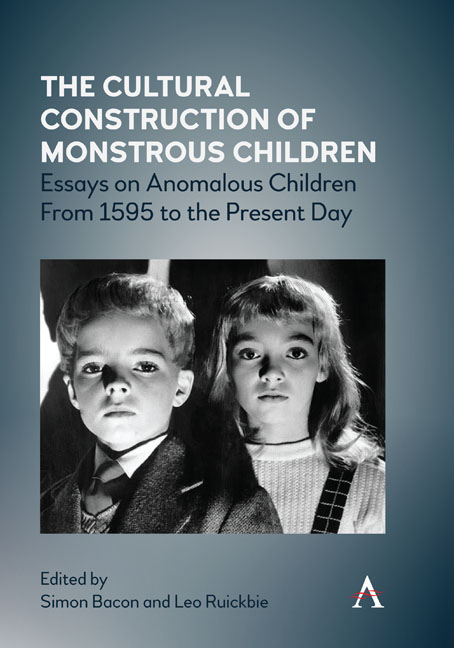 The Cultural Construction of Monstrous Children
The Cultural Construction of Monstrous Children Book contents
- Frontmatter
- Contents
- List of Illustrations
- Acknowledgements
- Introduction
- Part I Historical Case Studies
- Part II Factual Anxiety in Fictional Representations: The Undead Child
- Part III Factual Anxiety in Fictional Representations: The Monstrous Child
- Part IV Cultural Categorization in the Past, Present and Possible Future
- Notes on Contributors
- Index
Chapter One - The Possession of John Starkie
Published online by Cambridge University Press: 20 January 2022
- Frontmatter
- Contents
- List of Illustrations
- Acknowledgements
- Introduction
- Part I Historical Case Studies
- Part II Factual Anxiety in Fictional Representations: The Undead Child
- Part III Factual Anxiety in Fictional Representations: The Monstrous Child
- Part IV Cultural Categorization in the Past, Present and Possible Future
- Notes on Contributors
- Index
Summary
Introduction
On 4 January 1597, John Starkie, a boy about 13 years old, and the heir of one of the wealthiest families in Lancashire, was reading a book when ‘he was suddenly stricken down with an horrible scryke [screech], saying that Satan had broken his neck’. That night,
being in bed, he leapt out on a sudden, with a terrible outcry that amazed all the family. […] Then was he […] very fierce like a madman, or a mad dog, snacted [snapped] at and bit everyone that he laid hold on […] hurling bed-staves, pillows, or whatsoever at them, and into the fire.
This was, of course, disturbing for his parents, but it is hardly unusual for children to behave in hurtful and alarming ways. However, John's father, Nicholas Starkie, was convinced that John was in the power of a demonic evil. And this conviction was the result of the Starkie family's relationship with two people who practiced magic – a ‘witch’ called Edmund Hartlay and the well-known magician Dr John Dee. Behind John Starkie's strange behaviour, and his father's drastic interpretation of it, were some powerful and complex ideas about the connection between magic and the spirit world.
The Possession
John Starkie was the fifth child of Nicholas Starkie and his wife Anne, who was also from one of Lancashire's most powerful families. John had a younger sister, also called Anne, but the four older brothers and sisters they should have had were dead; all of them had ‘pined away in a most strange manner’ not long after being born. Although John and his sister had never known them, memories of them must have haunted their parents, and at times it must have been a difficult burden for John and Anne to be the consolation and hope that enabled their parents to live with their grief. There was a further painful complication: their mother had become convinced that the children had died as the result of a curse put upon them by her Roman Catholic relatives. Then, in February 1595, when Anne was 9 or 10 years old and John about 11, Anne began to suffer from seizures.
For parents who had already lost four children, watching Anne suffering from this ‘fearful starting and pulling together of her body’ was agonizing.
- Type
- Chapter
- Information
- The Cultural Construction of Monstrous ChildrenEssays on Anomalous Children from 1595 to the Present Day, pp. 23 - 38Publisher: Anthem PressPrint publication year: 2020


